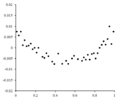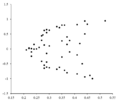Least squares facts for kids
Least squares is the name of a procedure in mathematics, to construct a function from a number of observed values. The basic idea is to construct the function in such a way that the sum of the difference between the observed value and its data point is minimized. Since the difference may go in either direction, the value of the difference is squared, for each value.
Carl Friedrich Gauss said he developed the method in 1795. He used it to recover the lost asteroid 1 Ceres and published it in 1807. He used ideas from Pierre-Simon Laplace. Adrien-Marie Legendre developed the same method independently, in 1805.
Related pages
- Ordinary least squares
- Lawson, C. L., & Hanson, R. J. (1995). Solving least squares problems (Vol. 15). SIAM.
- Bjorck, A. (1996). Numerical methods for least squares problems (Vol. 51). SIAM.
Images for kids
See also
 In Spanish: Mínimos cuadrados para niños
In Spanish: Mínimos cuadrados para niños

All content from Kiddle encyclopedia articles (including the article images and facts) can be freely used under Attribution-ShareAlike license, unless stated otherwise. Cite this article:
Least squares Facts for Kids. Kiddle Encyclopedia.



